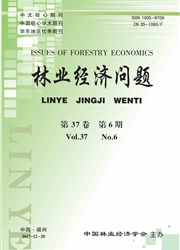

 中文摘要:
中文摘要:
首先运用边际成本模型和剩余需求弹性模型估算了中国板栗及其在主要出口国市场上的国际市场势力,发现加入WTO前,中国板栗国际市场势力较大,加入WTO后中国板栗国际市场势力下降;中国板栗在泰国的市场势力最大,在荷兰的市场势力次之,在日本的市场势力最小,说明中国板栗出口具有了一定的市场势力,但由于中国板栗出口价格总体趋于下降,低成本优势逐渐减弱,所获得板栗贸易比较利益逐渐减少,板栗的现实国际市场势力并不很明显。
 英文摘要:
英文摘要:
This paper uses the marginal cost model and the expand residual demand elasticity model to estimate international market power of China's chestnuts and found that international market forces of China's chestnuts are larger before joining the WTO, international market forces of China's chestnuts have dropped after joining the WTO, market forces are the largest in the Thailand market, market forces are followed in the Netherlands market, market forces are the smallest in the Japanese market, it indicates that China's vegetable exports has a certain amount of international market forces, but also the export price tends to decrease overall and low-cost advantages have gradually weakened, compara- tive interests in trade obtained by China's chestnuts have gradually reduced, real international market forces of China's chestnuts are not obvious.
 同期刊论文项目
同期刊论文项目
 同项目期刊论文
同项目期刊论文
 期刊信息
期刊信息
